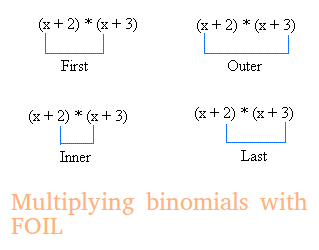Multiplying binomials using FOIL
The most commonly method used when multiplying binomials is FOIL. But what is FOIL?However, do not focus on trying to remember since I will show below that it is not that important to master multiplication of binomials.
The letter F stands for First
The letter O stands for Outer
The letter I stands for Inner
The letter L stands for Last
Let us discuss the example in the image below in more detail.
Let's say that you want to multiply (x + 2) and (x + 3)
(x + 2) * (x + 3)

F: Multiplying the first term of each binomial we get x * x = x2
O: Multiplying the outer term of each binomial, we get x * 3 = 3x
I: Multiplying the inner term of each binomial, we get 2 * x = 2x
L: Multiplying the last term of each binomial, we get 2 * 3 = 6
Combining everything, we get x2 + 3x + 2x + 6 = x2 + 5x + 6
Sounds easy, right?
Unfortunately, my 10 years of experience in teaching has shown me that using the acronym FOIL makes multiplying binomials a lot harder.
And again, it can be very confusing!
For instance, the position used for first is also used for outer and the one used for outer is also used for last.
The brain does not need all that extravagance!
Furthermore, when you get a problem like 2 * ( x + y) or (x + y) * (x + 2 + z), you wonder why FOIL was invented in the first place.
When multiplying binomials, I suggest you forget about the abbreviation FOIL and just do the problem naturally as I am going to explain.
Look at the following illustration:

Think of the problem as multiplying the first term in the first binomial ( binomial on the left ) by each term in the second binomial ( binomial on the right )
We get x2 + 3x
Then, multiply the second term in the first binomial by each term in the second binomial.
We get 2x + 6

Doing it this ensure that you are not thinking about inner, outer, or the like and get yourself confused.
Other examples about multiplying binomials
1)(x + -2) * ( 1 + x)
First, do:
x * 1 = x and
x * x = x2
Then, do
-2 * 1 = -2
-2 * x = -2x
Putting it all together, we get:
x + x2 + -2 + -2x = x2 + -x + -2 ( x + -2x = -x)
2)
(4x + 2) * (x + 1)
First, do:
4x * x = 4x2 and
4x * 1 = 4x
Second, do:
2 * x = 2x and
2 * 1 = 2
Putting it all together, we get:
4x2 + 4x + 2x + 2 = 4x2 + 6x + 2
Beyond FOIL:
2 * (x + y) = 2x + 2y
(x + y) * (x + 2 + z)
First, do:
x * x = x2
x * 2 = 2x
x * z = xz
Then, do:
y * x = yx
y * 2 = 2y
y * z = yz
Putting it all together, we get:
x2 + 2x + xz + yx + 2y + yz
Multiplying binomials should not be hard if you follow what I taught you here.